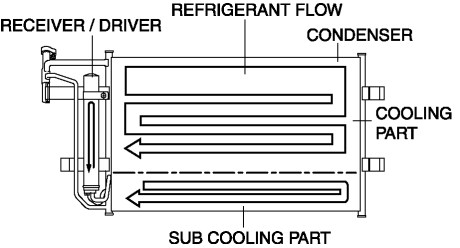Mazda CX-5 Service & Repair Manual: Condenser
Purpose
-
The condenser cools the high-temperature, highly pressurized refrigerant.
Function
-
The condenser cools the high-temperature, highly pressurized gaseous refrigerant compressed by the A/C compressor using the outside air, and changes it to liquid refrigerant.
Construction
-
The condenser is installed to the front of the radiator.
-
The condenser consists of the tube which passes refrigerant, and the heat radiation fin.

-
A sub-cooling condenser has been adopted.

-
The sub-cooling condenser is integrated with the multi-flow condenser and the receiver driver.
-
The sub-cooling condenser separates the refrigerant, cooled once by the condenser, into vapor and liquid using the receiver/drier, and by returning it to the sub-cooling part of the condenser again to cool.
-
As a result, liquefaction of the refrigerant is promoted and cooling performance is improved.
Operation
-
The high-temperature, highly pressurized gaseous refrigerant sent from the A/C compressor passes through the tube in the condenser.
-
When the air blown from the outside is exposed to the heat radiation fin, the heat of the refrigerant is captured by heat exchange, and the refrigerant changes from a gas to a liquid.
-
The liquid refrigerant is sent to the expansion valve via the receiver/drier.
Fail-safe
-
Function not equipped.
 Climate Control Unit [Manual Air Conditioner]
Climate Control Unit [Manual Air Conditioner]
Purpose
The climate control unit performs air conditioning according to the operation
by the users and the driving conditions of the vehicle.
Function
The climate control unit d ...
 Condenser Inspection
Condenser Inspection
1. Inspect the condenser for cracks, damage, and oil leakage.
If there is any malfunction, replace the condenser.
2. Visually inspect for bent fins for clogging of foreign material.
...
Other materials:
Speaker [Without Bose®]
Purpose
Converts the audio signal from the audio unit to sound.
Function
Full-range speakers, which can output wide-range sound from low to high frequency,
have been adopted.
Specification
Item
Front door speaker
Rear speaker ...
Steering Shaft Inspection
1. Inspect the steering column for excessive play and damage.
2. Verify that the clearance between the projection on the steering column shown
in the figure and the bracket is less than 2.0 mm {0.079 in}.
If the clearance between the projection and bracket is 2.0 mm {0.079 in}
or ...
Variable Valve Timing Mechanism
Outline
Achieves optimum valve timing according to the driving conditions by the
variable valve timing mechanism changing the phases of the camshaft.
An electric type variable valve timing mechanism on the intake side and a
hydraulic pressure type on the exhaust side has been ad ...
